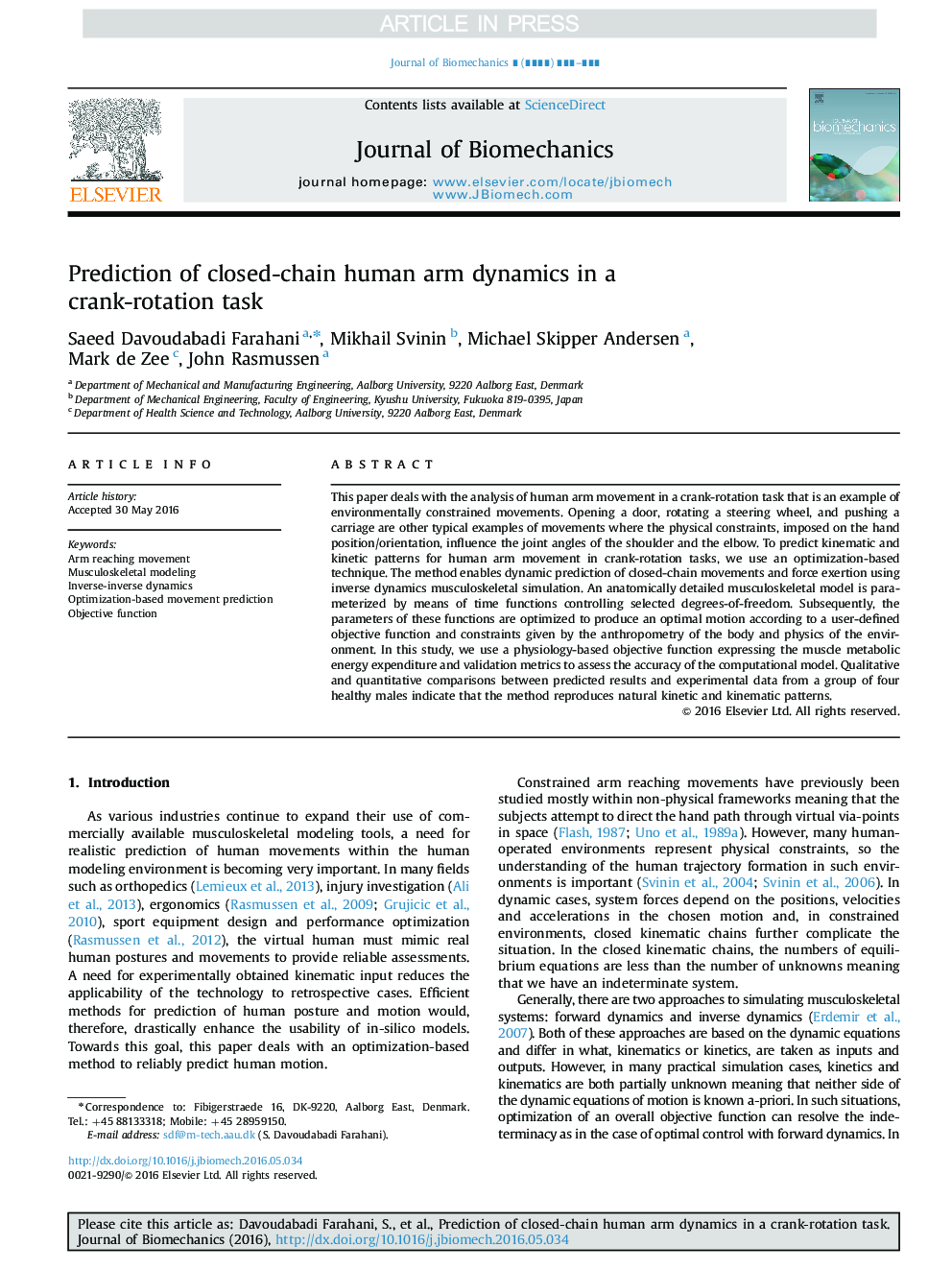| کد مقاله | کد نشریه | سال انتشار | مقاله انگلیسی | نسخه تمام متن |
|---|---|---|---|---|
| 5032440 | 1369984 | 2016 | 10 صفحه PDF | دانلود رایگان |
عنوان انگلیسی مقاله ISI
Prediction of closed-chain human arm dynamics in a crank-rotation task
ترجمه فارسی عنوان
پیش بینی دینامیک بازوی انسانی بسته در یک کار چرخشی میل لنگ
دانلود مقاله + سفارش ترجمه
دانلود مقاله ISI انگلیسی
رایگان برای ایرانیان
کلمات کلیدی
بازوی دستیابی به جنبش، مدلسازی اسکلتی عضلانی دینامیک معکوس معکوس، پیش بینی حرکت مبتنی بر بهینه سازی، تابع هدف،
ترجمه چکیده
این مقاله به تجزیه و تحلیل جنبش بازوی انسان در یک کار چرخش میل لنگی می پردازد که نمونه ای از حرکات محدود شده محیطی است. باز کردن یک درب، چرخش یک فرمان و فشار دادن یک حامل دیگر نمونه هایی از حرکات است که در آن محدودیت های فیزیکی اعمال شده بر روی موقعیت / جهت دستی، بر زوایای مشترک شانه و آرنج تاثیر می گذارند. برای پیش بینی الگوهای سینماتیک و جنبشی جنبش بازوی انسان در وظایف چرخش میل لنگ، ما از یک روش مبتنی بر بهینه سازی استفاده می کنیم. این روش پیش بینی پویا از حرکات زنجیر بسته و اعمال نیرو را با استفاده از شبیه سازی اسکلت عضلانی دینامیکی معکوس می کند. یک مدل عضلانی-عضلانی دقیق آناتومیک با استفاده از توابع زمان کنترل شده انتخاب شده از درجه آزادی، پارامتر می شود. پس از آن، پارامترهای این توابع بهینه سازی شده برای تولید حرکت بهینه با توجه به یک تابع اهداف تعیین شده توسط کاربر و محدودیت های آنتروپومتری بدن و فیزیک محیط است. در این مطالعه، ما از یک تابع هدف مبتنی بر فیزیولوژی استفاده می کنیم که بیانگر هزینه انرژی متابولیک عضلانی و معیارهای اعتبار سنجی برای ارزیابی صحت مدل محاسباتی است. مقایسهای کیفی و کمی بین نتایج پیش بینی شده و داده های تجربی از یک گروه چهار مرد سالم نشان می دهد که این روش، الگوهای طبیعی و جنبشی را تکثیر می کند.
موضوعات مرتبط
مهندسی و علوم پایه
سایر رشته های مهندسی
مهندسی پزشکی
چکیده انگلیسی
This paper deals with the analysis of human arm movement in a crank-rotation task that is an example of environmentally constrained movements. Opening a door, rotating a steering wheel, and pushing a carriage are other typical examples of movements where the physical constraints, imposed on the hand position/orientation, influence the joint angles of the shoulder and the elbow. To predict kinematic and kinetic patterns for human arm movement in crank-rotation tasks, we use an optimization-based technique. The method enables dynamic prediction of closed-chain movements and force exertion using inverse dynamics musculoskeletal simulation. An anatomically detailed musculoskeletal model is parameterized by means of time functions controlling selected degrees-of-freedom. Subsequently, the parameters of these functions are optimized to produce an optimal motion according to a user-defined objective function and constraints given by the anthropometry of the body and physics of the environment. In this study, we use a physiology-based objective function expressing the muscle metabolic energy expenditure and validation metrics to assess the accuracy of the computational model. Qualitative and quantitative comparisons between predicted results and experimental data from a group of four healthy males indicate that the method reproduces natural kinetic and kinematic patterns.
ناشر
Database: Elsevier - ScienceDirect (ساینس دایرکت)
Journal: Journal of Biomechanics - Volume 49, Issue 13, 6 September 2016, Pages 2684-2693
Journal: Journal of Biomechanics - Volume 49, Issue 13, 6 September 2016, Pages 2684-2693
نویسندگان
Saeed Davoudabadi Farahani, Mikhail Svinin, Michael Skipper Andersen, Mark de Zee, John Rasmussen,
